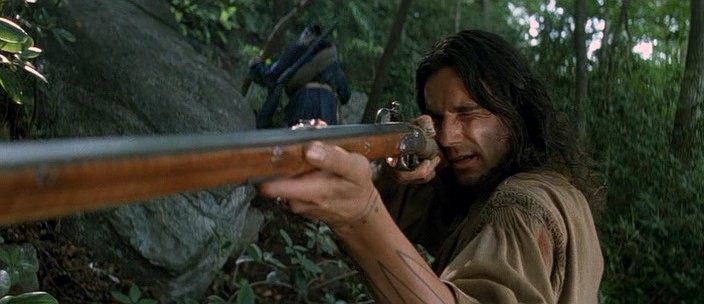Silk round ball patch
Evan Zabawski | TLT From the Editor August 2017
Hollywood fact or fiction?

The speed of the ball as it exits the barrel (muzzle velocity) is influenced by both the charge and the patch.
© 20th Century Fox Film Corporation
“TIGHT WEAVE?” “SILK. ANOTHER 40 YARDS.” This exchange in the film The Last of the Mohicans has always caught my interest. It takes place between a member of the colonial militia and the main character, Hawkeye, regarding the type of material Hawkeye is using as a patch when he loads his long rifle in readiness for a long-distance shot.
I had always presumed that a smoother fabric would result in less frictional loss as the shot traveled down the barrel, thereby resulting in further travel. After revisiting the film as it nears its 25th anniversary this month, I thought I would look a little further into the validity of Hawkeye’s remark, which does not appear in the text of the original book by James Fenimore Cooper.
To begin with, the process of loading a flintlock long rifle entails standing the rifle upright, pouring in a measured powder charge, tapping the rifle to help settle the powder, placing a lubricated cloth patch on the end of the barrel, centering the round ball (shot) on the patch, starting the bullet down using a bullet starter, ramming the bullet down the bore (using a ramrod) until it contacts the charge, priming the rifle and, finally, cocking the hammer.
The speed of the ball as it exits the barrel (muzzle velocity) is influenced by both the charge and the patch, and this speed ultimately affects the distance and accuracy of the shot. One other factor that only affects the accuracy is the rifling; these are the helical grooves that impart a spin to the ball. Pennsylvania rifles, like Hawkeye’s, typically had a very slow twist, being less than one complete turn over the nearly four-foot length of the barrel, suggesting speed is required for a fast spin.
The use of silk patches is confirmed in Holden’s Dollar Magazine, Vol. VI, No. III, from September 1850 and contains an article titled Three Chapters for Young Sportsmen, written by Charley Chase, which provides guidance regarding patch material selection. It says, “Place your patch – for which oiled canvas or silk will answer, but the finest kid leather, delicately greased, is the best article – square on the nozzle.”
Oiled canvas is simply another term for waxed cotton, which is cotton impregnated with beeswax or a paraffin-based wax. Other contemporary documents reference patch lubricant as commonly being rendered hog or sheep tallow, frequently mixed with beeswax, suggesting the chief difference between an oiled canvas patch and a silk patch is the material itself.
The rationale for even using a patch at all is not to separate the ball from the powder charge, as it is in pellet-loaded rifles, but rather to create a gas-tight seal around the ball to transfer as much of the energy from the explosion as possible without cutting the ball and leaving wear debris in the barrel. Given a .50-inch bore using a ball measuring .489-.491 inches, it leaves .0045-.0055 inches of a gap all the way around the ball. However, once the .01-inch grooves are factored in as well, the ideal material thickness becomes .015 inches ± .001 inches, which is about the thickness of card stock paper. Pillow ticking, which is a tight weave linen used to prevent down feathers from poking through the fabric, has a common thickness of .015 inches but may range from .010 to .020 inches.
Silk has a very similar thickness but a higher tensile strength, which may have greater resilience in preserving the seal around the ball as it travels the length of the barrel. This is reinforced by Henry Wilkinson (of Wilkinson Sword fame, a company now known for making shaving razors) when he wrote in his 1841 Engines of War, “I have found silk patches the best for very fine shooting, as they admit of using a larger ball than any other material without tearing or cutting, in forcing down the barrel.”
At least I have a better understanding of the logic and that it is not a friction-related decision, but hard data could prove if it actually yields greater distance.
 Evan Zabawski, CLS, is the senior technical advisor for TestOil in Calgary, Alberta, Canada. You can reach him at ezabawski@testoil.com
Evan Zabawski, CLS, is the senior technical advisor for TestOil in Calgary, Alberta, Canada. You can reach him at ezabawski@testoil.com.